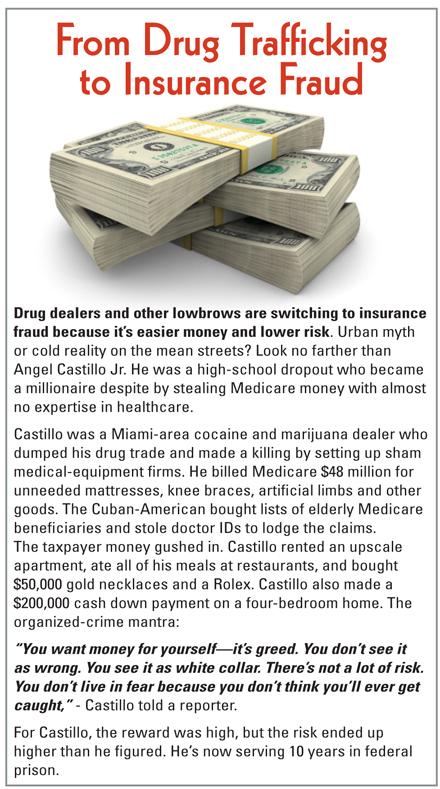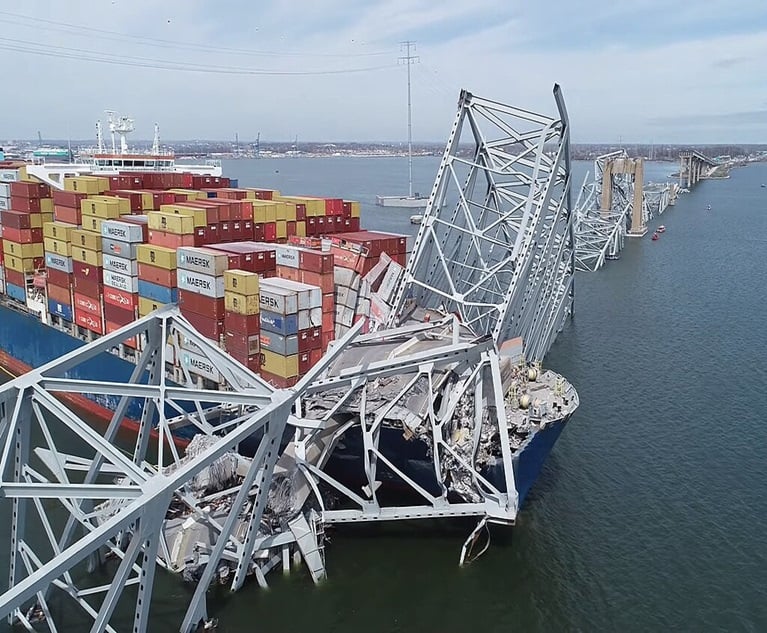Editor's Note: This article was contributed by Dennis Jay,the executive director of the Coalition Against Insurance Fraud(CAIF).
|Mikhail Zemlyansky was nothing if not ambitious. The Russiannative masterminded a sprawling crime empire that bled New Yorkauto insurers with seeming impunity.
|His gang made at least $400 million in dirty crash-injuryclaims, federal prosecutors say. That audacious money haul isnearly the team value of the Baltimore Orioles. It was the largest auto-fraud scheme in U.S. history until the gang wasbroken open this winter.
|If the federal RICO charges hold up, then Zemlyansky will be anominous signpost of the looting power of organized crimekleptocracies that keep infiltrating the insurance industry. Alphagangs are setting up efficient corporate-quality theft machinesthat are adroitly exploiting seams in the insurance system withincreasingly seismic heists.
|More Large-Scale Fraud Gangs
|Organized crime isn't new to insurance fraud. Gangs haveassaulted auto insurers, Medicare, and other insurance programs foryears. What appears to be new is an increased penetration ofinsurance by organized unsavories. The question is whethersteroidal stealing is so routine that it's becoming a new norm forinsurance fraud.
|“These crimes are often the work of well-organized,sophisticated rings whose successful schemes generate enormousprofits for the criminals and result in equally enormous losses toinsurance carriers and, ultimately, the public,” said a 2011 NewYork strategy report on how to combat auto fraud in the state.
|Data are in short supply, but the anecdotal case is building.Investigators frequently say they're seeing more gangs of largerscope, often tighter hierarchical organization and discipline, andwell-oiled looting ability. Several nine-figure fraud sprees havesurfaced just in the last few months alone. But whether the curveis way up, somewhat up or even flat, the fact is that organizedcrime maintains a dominant presence in the insurance-fraudbusiness.
|Organized crime itself is a slippery term. There's no easydefinition; call them fraud gangs or cartels. Whatever the name,they're large, complex and often-insular operations that can bedevilishly hard to penetrate. Some are homegrown; some arefranchises of overarching mafias back in the home country. Somerings are quite large; others are smaller but still highlyorganized enough to be called organized crime.
|Penetrating Ethnic Gangs
|Most fraud gangs tend to be ethnic. They are Russians,Armenians, Estonians, Latvians, Jamaicans and outfits from variedSpanish-speaking nations, to name just some. Ethnic gangs can behard to penetrate. They often stick largely to their ownnationality. The shared language and close family ties among gangmembers can erect a highly resistant barrier.
|Russian mobsters and those from former Soviet bloc countries arean especially forceful criminal presence in the U.S. The fall ofthe Soviet Union in 1991, for example, spawned numerous powerfulcrime gangs loosely known as the Russian mafia. They had learnedlittle respect for government in the old Soviet Union and haddeveloped acute survival skills by learning how to steal from thegovernment. These mobsters exported those talents to the U.S. andare putting them to work against insurance systems. The FBI evenhas a task force solely for Eurasian crime—and it played a largerole in Zemlyansky's takedown.
|Shifting Scams
|In fact, drug dealers and other mobsters are switching toinsurance because they perceive this crime as more lucrative,less-dangerous and possessing lower odds of being caught(see chart to the right below).
Regardless of nationality, the better-mobilized fraud operationscan lodge claims for hundreds of millions of dollars before they'rebusted. Many more gangs may be trolling silently underneath theinvestigative radar.
|Lawrence Duran was nailed with a whopping 50 years in federalprison last year for masterminding an attempted $205 millionransacking of the federal healthcare safety net for seniors. Acrony received 35 years.
|Duran crafted a network of thieving medical outfits throughoutFlorida. Among other tactics, recruiters trolled halfway houses foraddicts and alcoholics. The residents were bribed to receive bogusmental-health and sleep-disorder treatment billed to Medicare.
|Zemlyansky's suspected roughriders were centered in the Russianimmigrant enclave of Brighton Beach in New York City but stoleinsurance money in all city boroughs. He tried to lodge so manyfake injury claims that his ring needed three billing companiesjust to handle the paperwork, prosecutors allege.
|Recruiters monitored police radios to track down crash victimsat the scene. ER employees also alerted recruiters when crashvictims came in.
|Zemlyansky ran nine clinics in the Bronx, Brooklyn, and Queens.They allegedly provided worthless and excessive medical treatments,including physical therapy, acupuncture, pain management,psychological services, X-rays, MRIs and other services.
|Physicians, Lawyers Get Their Cut
|Doctors also were on the take. They were paid to act as illegalstraw owners of clinics actually dominated by gang members. Lawyerssued insurers, coaching the crash victims on what to say when autoinsurers interviewed them.
|The stolen insurance money was laundered through shellcorporations and corrupt check-cashing services, officials say.These defendants used the money to finance princelylifestyles—including vacations in Mexico and Atlantic City; blingfrom Louis Vuitton, Chanel and Saks Fifth Avenue; plus expensivejewelry and limos.
|Some 37 high-ranking members have been indicted. They aredoctors, lawyers, chiropractors, and other professionals. Ifconvictions come down, then Zemlyansky's suspected gang may begutted.
|Another aspect of the mega gangs: Much of the stolen moneyleaves the U.S. and may never be fully traced. What other crime themoney helps fund—beyond sports cars and mansions—is fuel for muchadded investigation.
|“These organizations are using part of this money forother things. It's been documented through investigations of thismoney leaving the county, leaving the state of Florida, whether itbe back to Cuba, Mexico, the Cayman Islands, Costa Rica. So it's alot bigger than what a lot of people understand, and the fact isthat it's not just a staged crash and it's not just insurancefraud,” Det. Ronnie Cooper, a special investigator with theHillsboro, Fla. sheriff's office, said in testimony about organizedcrime to the state legislature last year.
|A Sinister Underworld
|Insurance fraud thus links into a larger and more sinister crimeworld. Syndicates that bilk auto insurers often engage in bankingand credit card fraud, drugs and other crimes. Stolen insurancemoney could be helping finance these other crimes.
|Rings also may be franchises of, or at least tied to, larger moborganizations back in their home countries. Insurance fraud thenbecomes an integral part of larger spiderwebs of global corruptionand deceit. North Korea even has resorted to insurance fraud tohelp finance its crumbling economy, according to news reports.
|“The emergence of international organized crime in domestichealthcare fraud schemes signals a dangerous expansion that poses aserious threat to consumers as these syndicates are willing toexploit almost any program, business or individual to earn anillegal profit,” says Acting Deputy U.S. Attorney General Gary G.Grinder.
|A gang called Armenian Power (AP) illustrates the point. Nearly90 alleged members were arrested in February 2011. Thirteen werebased in Florida. They recruited car-crash victims to file falseclaims with insurers for phantom injuries. The group billedno-fault auto insurers for worthless medical treatment and servicestheir sham clinics never provided, according to the indictment.
|An Expanded Fraud Menu
|But insurance fraud was only part of AP's alleged portfolio.Identity theft, banking fraud, extortion, kidnapping, drugs, gunsand other crimes were on the menu. In one kidnapping scheme,several AP members allegedly seized a victim and forced him to payransom. Several defendants targeted another victim in an extortionscheme lasting several months. They threatened the victim and hisfamily to extract repeated payments, the FBI alleges.
|AP also deals directly with high-level Armenian/Russianorganized crime figures, both within the United States and abroad,the FBI says.
|Armen Karazianis is another cautionary tale. He was a vor, oroverlord, of a vast Armenian cartel in Southern California. He wasbusted last year in a takedown of dozens of Armenian gangsters.Karazianis erected 118 sham medical clinics spanning 25 states. Helooted insurers with $160 million in claims for worthless medicaltreatment.
|His bust last year “provides additional evidence of the effortsby international organized crime to defraud the Medicare system,”said U.S. Attorney Edward Tarver. He staged crashes togenerate bogus injury claims. The gang funneled kickbacks to anemployee of a New York City hospital. The employee stole the namesand identities of patients. They were recruited for worthlesscrash-injury treatments, with Karazianis' mobsters creating a fakehospital-referral service for crash victims. Some patients receivedpainful nerve-conduction tests regardless of medical need,prosecutors say.
|Bleeding The Medicare System
|But Karazianis specialized in bleeding Medicare, a favoritetarget of fraud rings. He masterminded one of the bigger attemptedMedicare heists in history—$163 million in false claims.
|Many clinics were sham. No patients came for treatment, and nodoctors were on staff. He simply invented patients and treatmentsand then slid the bills through Medicare's payment system. One“clinic” in New York was merely a small office over an auto-bodyshop in Coney Island.
|One of his clinics stole the identities of 2,900 Medicarepatients in Orange County, Calif., prosecutors charge. Theirinformation was used for fake claims involving bladder tests,pregnancy ultrasounds and other treatments. He also specialized inkidnapping, extortion, credit-card fraud and counterfeitchecks.
|Karazianis received three years in federal prison in 2011. Thesentence was relatively light, but he was the first vor everconvicted. That alone sent a loud message to vors of other Armeniangangs.
|Theft By Force
|Violence and intimidation also can be part of the newfraudscape. Organized crime rings enforce discipline, expandterritory and settle scores. Kelechi Chukwueke, for example, stagedcar crashes, auto thefts and other cons in California. His gangthreatened girlfriends, acquaintances, relatives and neighbors intotaking part.
|Some 22 of his gang members were convicted after an eight-yearromp that stole at least $500,000 in insurance money. Chukwuekealso illustrates another principal: Many organized crime gangs aresmaller than their blimp-sized brethren but are still quiteeffective.
|Florida's fraud bureau, for instance, recently launched anongoing takedown called Operation Dark Horizon. It's the state'slargest no-fault auto-insurance bust in recent years.
|Five clinics allegedly were involved. At least 26 suspected gangmembers were arrested. They included a clinic owner, doctors,clinic employees and staged-crash recruiters and others. Threegenerations of one family allegedly took part—a mother, daughterand granddaughter.
|Corporate-Caliber Gangs
|The rise of corporate-caliber gangs with international ties andmulti-industry scams raises the ante by several degrees ofmagnitude for fraud fighters, especially in auto, health, andworkers' compensation. The investigative model of the future thuswill involve ever-higher levels of collaboration in variedpermutations.
|Task forces and other units focused solely on organized crimeand specific ethnic groups already are a large part of theanti-fraud landscape at the federal, state and even city levels.The coordination can be intricate.
|But the government and private sectors also will come togetherin other ways and work across lines of insurance.
|Organized crime gangs are multitasking across lines ofinsurance. The same gang may be fleecing Medicare and runningmedical mills connected to staged-crash rings. But we don't knowhow big the problem is because fraud fighters in different linesdon't often compare notes.
|The days of investigators operating in silos are numbered—autoinsurers tackling crash gangs, health insurers chasing down healthgangs, and workers' compensation insurers hunting their medicalmills.
|Presenting A United Front
|Closer coordination of investigations among the lines ofinsurance—and between the public and private sectors—is thenecessary model of the future. This highly integrated approach willunearth far more well-hidden crimes, case leads and evidence thancan each sector working largely alone.
|Private insurers have large bodies of insight and leads aboutauto and health scams as well as known crooks. The feds alsohave large pools of information about Medicare and Medicaid cons.So it makes perfect sense to work in tandem. Anti-fraud vocabularyalso could change. The term “medical fraud” may become the commonlyused umbrella term for bogus treatment involving crash rings,health insurers and workers' comp medical mills.
|The feds and private sector are collaborating more regularly oninsurance cases. It's still relatively informal, and a work inprogress, but important progress is being made.
|And with so many organized-crime gangs working multiple crimessuch as insurance, banking, and credit-card fraud, the concentriccircles of anti-fraud collaboration and information sharing thusshould keep extending farther outward to other industries andrelated government agencies—domestic and international.
|If more of the vast criminal underworld perceives insurancefraud as a soft and lucrative target, the insurance industry couldwell continue seeing a growing penetration by organized criminals.This will only increase the already debilitating outflow ofinsurance money and place yet more upward pressure on premiums. Andthat stolen money may help finance other domestic and internationalcrime that erodes American society and its values.
|The insurance industry is entering uncharted waters ofcooperation and collaboration. The challenge is to be moreorganized than organized crime.
|Want to continue reading?
Become a Free PropertyCasualty360 Digital Reader
Your access to unlimited PropertyCasualty360 content isn’t changing.
Once you are an ALM digital member, you’ll receive:
- All PropertyCasualty360.com news coverage, best practices, and in-depth analysis.
- Educational webcasts, resources from industry leaders, and informative newsletters.
- Other award-winning websites including BenefitsPRO.com and ThinkAdvisor.com.
Already have an account? Sign In
© 2024 ALM Global, LLC, All Rights Reserved. Request academic re-use from www.copyright.com. All other uses, submit a request to [email protected]. For more information visit Asset & Logo Licensing.








